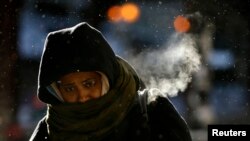OTTAWA, ILLINOIS —
A large section of the United States is under a deep freeze, thanks to a blast of cold, dense air moving in from the north. The record-setting low temperatures in the Midwest United States have forced many offices, schools, and businesses to close as people are being encouraged to wait out the deep freeze, indoors at home.
Rural Illinois resident Karen Brodbeck thought she had seen the worst cold weather during a December trip to visit her brother in Edmonton, Alberta, Canada.
“They had wind chills that were negative 40 degrees Fahrenheit (-40 Celsius). That was the coldest weather I had ever experienced in my life,” she said.
Little did Brodbeck know that weather would follow her all the way back home to Illinois, 2,630 kilometers away, where on January 6, the wind chill was negative 45 degrees Celsius.
“I am sure it is warmer in the North Pole or something than it is here,” she said.
The extreme cold weather blanketed a large portion of the U.S. Midwest, forcing the closures of schools, government offices, and businesses throughout the area that have taken note of health warnings from local governments.
Brodbeck, who is the marketing and community relations director for a local medical center, says the weather has scaled back some of the operations of the center in an effort to protect patients and staff members.
“Temperatures are dangerously low, to the point that just being outdoors just five to 10 minutes you can start to experience frostbite and symptoms of hypothermia," she said. "So it is a very real and dangerous possibility.”
Source: World Meteorological Organization
The cold snap comes on the first day back to work for many who were on an extended break for the Christmas and New Year holiday.
But according to some mass transit customers, it was not business as usual on commuter trains in the city of Chicago.
“There was probably only 10 percent of the usual commuters this morning. In the residential part of my neighborhood, it was like a ghost town,” said Veronica LaPage Skubal.
But despite the widespread closures, the cold did not prevent her from reaching her office in downtown Chicago.
“Us Chicagoans are tough, and things needed to get done today, and even the weather could not stop us, so we all came in, and actually our whole office except for one person made it in today,” she said.
Skubal’s office overlooks Lake Michigan, providing her and her co-workers with a unique view of the Great Lake reacting to the bitter cold spell.
“We were jokingly calling it the clouds of hell over the lake," she said. "You can see the vast lake out there, and there is just crazy steam or clouds of white smoke coming off the lake ... I have never seen it like that.”
It is a phenomenon that could continue for a second day as temperatures in Chicago and throughout the region remain at near-record lows before heading east.
Rural Illinois resident Karen Brodbeck thought she had seen the worst cold weather during a December trip to visit her brother in Edmonton, Alberta, Canada.
“They had wind chills that were negative 40 degrees Fahrenheit (-40 Celsius). That was the coldest weather I had ever experienced in my life,” she said.
Little did Brodbeck know that weather would follow her all the way back home to Illinois, 2,630 kilometers away, where on January 6, the wind chill was negative 45 degrees Celsius.
“I am sure it is warmer in the North Pole or something than it is here,” she said.
The extreme cold weather blanketed a large portion of the U.S. Midwest, forcing the closures of schools, government offices, and businesses throughout the area that have taken note of health warnings from local governments.
Brodbeck, who is the marketing and community relations director for a local medical center, says the weather has scaled back some of the operations of the center in an effort to protect patients and staff members.
“Temperatures are dangerously low, to the point that just being outdoors just five to 10 minutes you can start to experience frostbite and symptoms of hypothermia," she said. "So it is a very real and dangerous possibility.”
The World's Coldest Temperatures
The World's Coldest Temperatures- Antarctica: -89.2°C Vostok, Antarctica in 1983
- Asia: -67.8°C Verkhoyansk, Russia in 1892 and Oimekon, Russia in 1933
- North America: -3°C Snag, Yukon Territory, Canada in 1947
- Europe: -58.1°C Ust'Schugor, Russia in 1978
- South America: -32.8°C Sarmiento, Argentina in 1907
- Africa: -23.9°C Ifrane, Morocco in 1935
- Australia: -23°C Charlotte Pass, New South Wales, Australia in 1994
Source: World Meteorological Organization
But according to some mass transit customers, it was not business as usual on commuter trains in the city of Chicago.
“There was probably only 10 percent of the usual commuters this morning. In the residential part of my neighborhood, it was like a ghost town,” said Veronica LaPage Skubal.
But despite the widespread closures, the cold did not prevent her from reaching her office in downtown Chicago.
“Us Chicagoans are tough, and things needed to get done today, and even the weather could not stop us, so we all came in, and actually our whole office except for one person made it in today,” she said.
Skubal’s office overlooks Lake Michigan, providing her and her co-workers with a unique view of the Great Lake reacting to the bitter cold spell.
“We were jokingly calling it the clouds of hell over the lake," she said. "You can see the vast lake out there, and there is just crazy steam or clouds of white smoke coming off the lake ... I have never seen it like that.”
It is a phenomenon that could continue for a second day as temperatures in Chicago and throughout the region remain at near-record lows before heading east.













